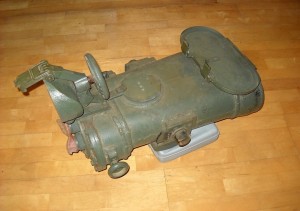Item: WW2 Imperial Japanese Navy “Big Eye” Submarine Radar Binoculars
Sold For: $22,999.99
Bids: 35
Date: Jul 26, 2012
Auction: Ebay
Description and Image By: messerschmitt*109
Japan had what was easily the most diverse submarine fleet of any nation in the Second World War. These included manned torpedoes, midget submarines, medium-range submarines, purpose-built supply submarines (many for use by the Army), long-range fleet submarines (many of which carried an aircraft), submarines with high submerged speed, and submarines that could carry multiple bombers.
The sad feature is that they lacked radar capabilities until June 1944. These massive pressure proof binoculars were mounted at the froward end of the bridge of I-14, I-400, and I-401. They covered arcs to port and starboard and were an attempt to compensate with oversized optics for the inadequate performance of Japanese radar. These 20 x 120mm binoculars were to remain on the conning tower and deck at all times, and made to withstand the pressures of diving 300ft (100 meters). In addition, they also had to handle depth charge attacks, and the optic had to retain collimated and ready for use when the submarine surfaced. Made of a solid steel, this set of binoculars is in AMAZING used condition, and I have ever only seen one other example! They retain 98% of their original camouflage paint, and all optics are VERY CLEAR and work 100%. No chips or cracks! The data label shows a manufacture date of March 1945, with a serial number of 377. All information is clearly legible, including the manufacture “Nippon Gogaku” ( Nikon ). There are massive welds with a watertight seal at the rear, and are pressure proof up to 330 feet (100 meters).
The 120mm front objectives are recessed, and are protected by thick front glass plates that are 13mm thick. A bit oversized, these plates measure 135mm in diameter. The lenses are then incased in a waterproof seal, secured tightly with 12 bolts on each side, and finally a large steel shield that swings down for protection. The rear of the binoculars feature a large rotating wheel, which allows the waterproof hatch to swing upwards or downwards, revealing the eyepiece. A rotating scale located internally is used to adjust the distance between the eyepieces for varying widths (dependant on the user). A rubber seal surrounds the open hatch at the rear. On the top is a large round reservoir, that indicates, “Kansozai” on the lid. This contains a desiccant silica gel that prevents fogging and moisture to form internally – this too is also secured by 12 bolts to make it watertight. Internally, the prisms on these binoculars are larger than the standard Japanese 20×120 binoculars (apparantly by several millimeters).
Recovered from a Japanese submarine by a US veteran, this is the largest Japanese binocular set I have ever seen, and it measures in at a MASSIVE 31″ x 14″ x 10″, and weigh approx. 170lbs. They retain the original foam/rubber eye cups, which are usually missing or damaged on most Japanese optical equipment. I suspect that due to the large size, this was not an item that many vets brought home with them, thus making it EXTREMELY RARE!
I have shown the exact optics on the I-14 and I-401 submarines while in Hawaii (see last photos). After examining hundreds of Japanese Submarine photos, I have only ever found this type on the A2 and Sen-Toku I-400 class submarines, which were the largest in the world until the ballistic submarines of the 1960’s. As the crew members of the USS Missouri did not have time for shore leave to claim war-prizes in Japan, it can be assumed that these were taken from the I-401, I-400, or I-14 by T.C Ewen while in Tokyo Bay after the signing of the Peace Treaty. The amount of wear on the brass mounts also confirm that these were removed from an active submarine, as oppsoed to being found as “new stock”. After I-401 was strafed by US Fighters in 1945, as well as running aground, and eventually running into a mine dropped by a B-29 Superfortress, she underwent repairs in May 1945. By June 1945, all repairs were completed. These dates coincide with the late-war manufacture date of March 1945 on these binoculars. I suspect these are from this specific submarine, but m
ore research does need to be done however, and I have only scraped the surface on the history of these binoculars.

